| کد مقاله | کد نشریه | سال انتشار | مقاله انگلیسی | نسخه تمام متن |
|---|---|---|---|---|
| 4730922 | 1356785 | 2014 | 13 صفحه PDF | دانلود رایگان |

• The ore forming fluid is high temperature with low to moderate salinity.
• The deposit probably formed from reduced fluid under low pressure.
• Mineralization probably mainly caused by boiling and immiscibility.
• Fluorine may play an important role in mineralization.
• The deposit probably is the high temperature part of the Gejiu mineralization system.
The newly discovered Xi’ao Cu–Sn polymetallic deposit is located in the inner alteration zone of the Laochang–Kafang granite edge in Gejiu, Yunnan Province. The mineralization process of this deposit can be divided into four stages. Cassiterite and chalcopyrite mainly formed at stages II and III, respectively. Fluid inclusions at different stages were studied by petrography, microthermometry, and laser Raman spectrometry. Five fluid inclusion types are observed. Microthermometry results revealed that the ore-forming fluid evolved from high temperature with low to intermediate salinity to low temperature with low salinity. At stage I, the fluid was under near–critical conditions and then separated into coexisting liquid and vapor phases at stage II. Finally, the fluid was boiling and immiscible at stage III. A meteoric fluid mixing process was also observed at this stage. Laser Raman spectra identified CH4 at the skarn and mineralization stages. Combined with other geological features, the deposit was concluded to have formed under a relatively reduced environment. The CO2 component abruptly increased at stage III and probably originated from the exterior. Fluorine may play an important role in mineralization. Cassiterite and chalcopyrite were mainly deposited at 340–440 and 300–400 °C under pressures of 18–50 and 12–36 MPa, respectively. Boiling and immiscibility are probably the main reason for mineral deposition. The deposit of cassiterite and chalcopyrite showed similar salinities but higher temperatures than other mineralization types of deposits in the Gejiu area. This finding indicated that the study deposit probably represents the high-temperature part of the Gejiu mineralization system, thereby benefiting mineral explorations in the Gejiu area.
Journal: Journal of Asian Earth Sciences - Volume 79, Part A, 5 January 2014, Pages 455–467